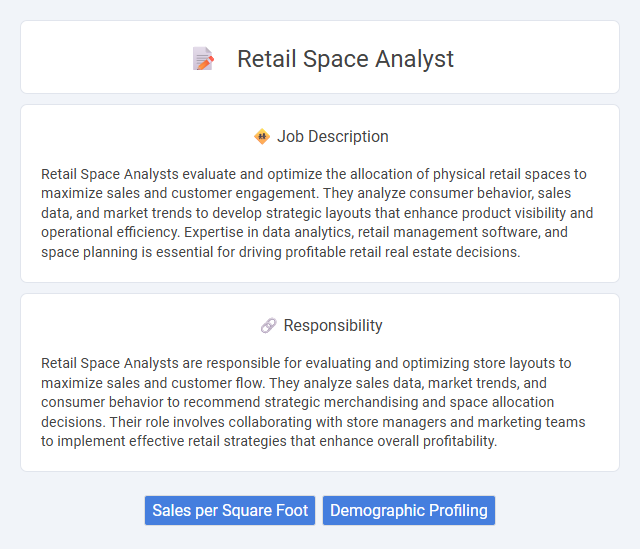
Retail Space Analysts evaluate and optimize the allocation of physical retail spaces to maximize sales and customer engagement. They analyze consumer behavior, sales data, and market trends to develop strategic layouts that enhance product visibility and operational efficiency. Expertise in data analytics, retail management software, and space planning is essential for driving profitable retail real estate decisions.
Individuals with strong analytical skills and a keen attention to detail are likely suitable for a Retail Space Analyst role, as the job demands careful evaluation of sales data and store layouts. People who thrive in environments requiring critical thinking and adapting to rapidly changing market trends might find this position aligns well with their strengths. Those who struggle with data interpretation or prefer less dynamic work settings may face challenges in performing effectively in this role.
Qualification
A Retail Space Analyst requires strong analytical skills, proficiency in data visualization tools like Tableau or Power BI, and experience with GIS mapping software to optimize retail layouts and site selection. Advanced knowledge of statistical software such as Excel, R, or Python enhances the ability to interpret consumer behavior and sales data for strategic decision-making. A bachelor's degree in retail management, urban planning, geography, or a related field is typically essential, with preference given to candidates possessing relevant industry certifications.
Responsibility
Retail Space Analysts are responsible for evaluating and optimizing store layouts to maximize sales and customer flow. They analyze sales data, market trends, and consumer behavior to recommend strategic merchandising and space allocation decisions. Their role involves collaborating with store managers and marketing teams to implement effective retail strategies that enhance overall profitability.
Benefit
Retail Space Analyst roles likely offer significant benefits including enhanced data-driven decision-making skills, which can improve store layout and sales performance. The position probably provides opportunities to collaborate with marketing and operations teams, fostering cross-functional expertise. Employees in this role may experience career growth potential due to the increasing reliance on analytics within retail strategy.
Challenge
Retail Space Analyst roles likely involve the challenge of accurately predicting customer behavior patterns and optimizing store layouts to maximize sales. The position probably requires navigating complex data sets while balancing competing interests from marketing, sales, and operations teams. Managing the uncertainty of fluctuating market trends and consumer preferences could also be a significant ongoing challenge.
Career Advancement
A Retail Space Analyst leverages data-driven insights to optimize store layouts, product placement, and inventory management, directly impacting sales performance and customer experience. Mastery of analytical tools and retail metrics enhances decision-making skills and opens pathways to senior roles such as Retail Operations Manager or Commercial Analyst. Continuous professional development in data analytics and retail strategy significantly accelerates career growth in this dynamic sector.
Key Terms
Sales per Square Foot
Retail Space Analysts evaluate sales per square foot to optimize store layouts and maximize revenue efficiency. They analyze historical sales data, customer traffic patterns, and product placement to identify high-performing areas and underutilized spaces. Their insights help retailers increase profitability by strategically allocating merchandise and improving overall floor space productivity.
Demographic Profiling
Retail Space Analysts utilize demographic profiling to assess consumer characteristics such as age, income, and lifestyle within a specific trade area, enabling precise site selection and targeted marketing strategies. By integrating geographic information systems (GIS) and demographic databases, they identify high-potential locations that align with the retailer's customer base, optimizing sales performance. Their expertise in interpreting population density, purchasing power, and socio-economic trends drives data-driven decisions that enhance store placement and expansion planning.
 kuljobs.com
kuljobs.com